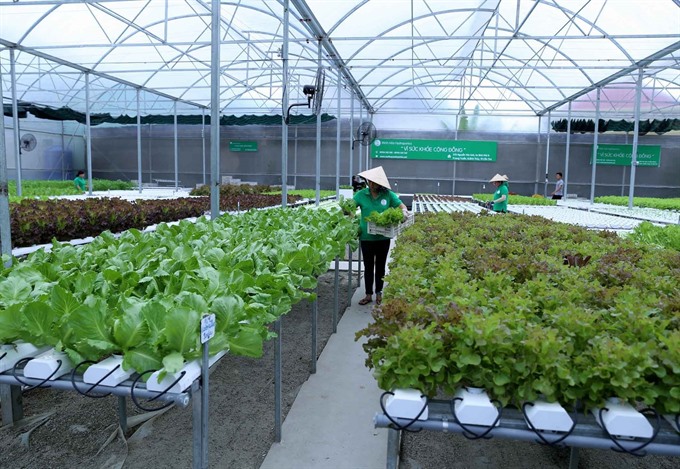 Society
Society

The Mekong Delta city of Cần Thơ is promoting advanced farming techniques to increase profits for farmers and enhance product competitiveness.
 |
| Vegetables are cultivated under a hydroponic method in Cần Thơ City’s Bình Thủy District.– VNA/VNS Photo Vũ Sinh |
CẦN THƠ – The Mekong Delta city of Cần Thơ is promoting advanced farming techniques to increase profits for farmers and enhance product competitiveness.
Nguyễn Ngọc Hè, director of the city’s Department of Agriculture and Rural Development, said that many efficient hi-tech agricultural production models were being used in the locality.
The city has set up large high-tech rice fields in which farmers co-operate with companies to produce high-quality rice for exports.
The city has 93 large rice fields with a total of nearly 20,000ha.
Concentrated fruit areas like milk apple - growing areas and Burmese grape areas are developed in Phong Điền District, Hòa Lộc mango areas in Cờ Đỏ District, and Ido longan areas in Thốt Nốt and Phong Điền districts.
Many farmers have applied Vietnamese Good Agricultural Practices (VietGAP) standards and automatic irrigation equipment for planting fruits and vegetables.
Most tra fish breeders in the city have also applied VietGAP standards.
Nguyễn Ngọc Hải, chairman of the Thới An Ward Tra Fish Breeder Club in Ô Môn District, said: “All of the nearly 100ha tra fish farms in Thới An Ward use VietGAP standards.”
The ward’s tra fish ponds have been granted identification numbers to ensure traceability.
Breeding tra fish under VietGAP offers 10 – 15 per cent higher profits than traditional farming methods.
Rice, fruit and fish are the city’s main agricultural products. The city has more than 85,000ha of rice with an annual output of 1.3 million tonnes, 18,000ha of fruits with an annual output of 62,000 tonnes and 8,520ha of aquaculture with an annual output of 200,000 tonnes.
Challenges
Nguyễn Minh Toại, director of the city’s Department of Industry and Trade, said the area has advantages in rice, fruit and fishery production, but is facing unstable markets and low agricultural product competitiveness.
To increase the value and competitiveness of products, co-operation between co-operatives and companies should be improved, and key agricultural products should be promoted via production, purchasing, preservation, process and consumption.
This would raise profits for farmers and attract investors in the agricultural sector.
The Department of Agriculture and Rural Development should encourage farmers to work together to set up co-operatives and co-operative teams.
The city has identified high-tech agriculture, commerce and services, industry and construction, as its three key economic pillars.
Cần Thơ has nearly 117,000ha of farming area, accounting for more than 80 per cent of the city’s total area.
Climate change, small and scattered farming areas, lack of regular outlets and high costs of investing in high-tech agriculture are obstacles that farmers, co-operatives and companies face in investing in high-tech agriculture, according to the Department of Agriculture and Rural Development.
The city called on investors in four high-tech agricultural projects with total investment capital of VNĐ1 trillion (US$44.5 million) in August. Of the projects, only one has received an investment agreement.
The city aims for agricultural growth of 3.5 per cent a year to 2020.
Hè said the city would promote high-tech agricultural methods to produce clean and organic rice for export and domestic consumption.
The Trung An High-tech Farming Joint-Stock Company in Thốt Nốt District will be allowed to turn 3,000ha of large rice fields in Cờ Đỏ District into fields under Global GAP standards from now to 2020.
Phạm Thái Bình, general director of the company, said his company was co-operating with farms in Kiên Giang Province’s Hòn Đất District to produce Global GAP and organic rice on a total area of 800ha.
Farmers who participate in planting rice under Global GAP standards earn a profit of VNĐ8-9 million ($342 – 385) more per ha per crop than those who plant rice under traditional farming methods, he said.
The city has certified 22 safe food supply chains with 72 agricultural, fishery and forestry products produced by companies and co-operatives over the past three years.
The products, which include rice, vegetable sprouts, eggs and cow milk, are sold in shops and supermarkets nationwide and exported.
The Department of Agriculture and Rural Development will continue supporting co-operatives and companies to build safe food supply chains for its agricultural products.
Food supply chains help trace origin of the certified products, from production to the end user. – VNS




